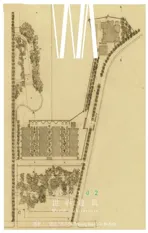水电站美术馆,北京,中国
2021-03-02建筑设计未觉建筑
建筑设计:未觉建筑
在废墟上重建
水电站美术馆,地处北京密云水库,原有建筑是一座废弃已久的水电站,实际是一间不足100m2的1960-1970年代的平房。建筑师的设计任务是把这个小院子改造成一座美术馆,包括陈列3件雕塑展品的永久展厅、文化沙龙、餐饮空间及微型酒店。
水库的大坝与水电站通过一段1100m长的露天水渠连接,设计师选择将美术馆的辐射范围延展到水渠,观展的主入口设在大坝的渠口,水渠里布置了给艺术家做艺术装置的点位,参观者需要步行20多分钟穿过整条水渠才能进入美术馆的内部。顺着曾经水流的方向,穿过各个年代遗留的痕迹,缓慢地进入水电站的地下机房,也就进入了美术馆的中心庭院。这条水渠是水电站“生命力”的历史线索,也是开启它新使命的主要路径。
柔和的新建
现场遗留着不同年代的痕迹,工业时期的机械零件,村居使用的毛石、粘土以及邻近山脚的片石,与小院里原本生活用的砖房混杂在一起。红砖、灰砖,甚至十几年前的瓷砖穿插在一个场景里,极具时间性。然而我们并不希望只是简单地重塑或是整理这些年代留下的碎片,因为新建筑的功能需求无法在旧建筑中得到满足,所以它的目的不应该是被用来缝补缺失了的旧样貌,而应是在尊重周边环境的尺度和关系的基础上,创作出更适合这个新场景的建筑。
在尺度和外型轮廓上延续了周边建筑的基调,新建的外立面使用半透明的聚酯纤维板,新建的建筑体无论由内向外、还是由外向内都透出漫反射的柔光。用这种新材料的柔与虚对话现场保留下来的石头、旧砖和水泥的硬与实,目的是想探讨新与旧之间的平衡与相对关系。
内和外
遗憾的是现存建筑的体块无法满足新功能所需的使用面积的要求,于是我们把平面反转,原来的室内部分变成了室外,原来的室外院落变成了室内。原有的水电站,保留了废弃的设施、墙体和门窗,只去掉了水泥平顶,变成了美术馆的室外中心庭院。原有的院落加上了新的顶盖,变成了美术馆的一层展厅。沿着外部道路的方向水平布局了一个长条的展厅,轻柔地“浮”在旧院墙的上端,一条透明玻璃幕墙连接新建筑与旧墙,在视觉上可以脱开新旧的交接,为的是减弱新的体量对现状可能有的视觉压力。
依托于原始水电站的门卫用房,我们谨慎地布置了9间客房,尽量延续周边村居的房屋轮廓和体量关系,并且将其布置在末端尽量靠近山体,用山体的体量和透视关系来弱化有可能对周边现存场景的影响。原始门卫用房的小院被保留下来。一个新建的钢楼梯利用水渠与机房交接的空间设置,成为客房的入口,利用楼梯的架空,水渠里收集的山泉、雨水通过新建的水系缓慢地流向美术馆的新入口。水渠的新旧关系在交错混合中重新组合并且寻找适合的定位。

1 动线分析/Traffic fiow analysis

2 场地拆除信息/Site removal information

3 鸟瞰/Aerial view rendering

Built on the Ruins
Tourism in the rural countryside has seen an upturn within China in recent years, with many of the younger demographic finding this a popular alternative to international trips. This has led to a boom in boutique hotel industry implanted in villages, with high demand for an authentic experience. The power station complex was considered an ideal location to renovate due to its proximity to the great wall and natural scenic beauty.
Built during the 1950s-1960s the hydroelectric power station provided electricity for the surrounding farming communities. Water for the hydroelectric station was funnelled from a small man made dam, 1 km upstream along an aqueduct which hugs the mountain ridge. A turbine hall is housed in the basement of a single industrial brick control station and accessible through a single set of stairs. The site was a mixture of the remnants from the recent past. Dormant Industrial machinery,walls of mud brick concrete and rubble, vegetation,previous excavations of mountain faces. The site encompassed homes from the village some inhabited others in a state of dereliction.
Inside Out
waa was tasked in adapting this industrial building and designing the surrounding masterplan scheme with a programme of permanent Gallery to exhibit three main programmes: a salon, a restaurant and a hotel. It was decided to draw out and stretch the time to enter the main cluster. To impart this previously hidden process we engaged visitors to walk the aqueduct, and form a processional route to the building. Visitors enter at the tip of the dam one kilometre away echoing to the historical route of water. A series of site speci fic arts interventions where planned to be curated along this route, and we hoped the experience brings awareness to traces of recent industry and awareness of power generation process.
Unfortunately the existing area of the power station was insufficient to function in its new incarnation and required greater area. The plan was reversed, fiipped inside out so the surrounding site was to be made internal, to maximise the available area of the yard into a ground floor which encompasses a multifunction salon and offices. Memories of the past where enshrined through keeping selected machinery, retaining walls windows from demolished buildings, and perimetres of previous homes and courtyards.The old power station's roof was removed and this now became a focal central courtyard from which all massing orientates towards. A prominent Site speci fic sculpture was commissioned to occupy the centre of this courtyard and access was maintained to the turbine room below, beneath the sculpture.The courtyard can be viewed from the accessible roof. It allows views down to the courtyard, and acts as access to a long linear permanent gallery space, balanced parallel to the road. Sitting parallel to the site constructed in poly carbonate this acts as a beacon in the surrounding valley. Adjacent to the gallery we carefully arranged a cluster of 9 hotel rooms to fit the scale of the existing village context addressing the inner courtyard. These push back to minimise the visual obstruction for the village.Access is granted to the aqueduct from an additional courtyard housing a staircase for roof access. The water path once destined for the turbine has been detached, it spews water into a central pool, a fitting symbolic gesture to the past.
Within such rich context it was easy to mark time through existing layers and traces of past expansions and slap dash fixes. We chose to use semi-translucent polycarbonate, it provides soft internal light and surreal optical effects help to balance a lightness of touch against the rock, brick and concrete whose rough hard remnants dot the site. This new layer for future was not a case of replicating a local vernacular more a sequence of revealing archeological portions of this context in careful order. The design aims to create a balance between change and the awareness of reading time selectively through modern materials.

10 餐厅庭院/Restaurant courtyard

